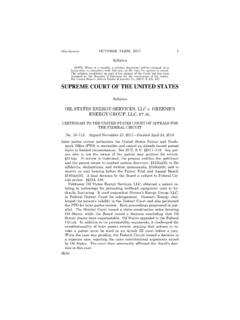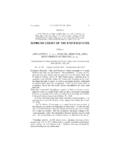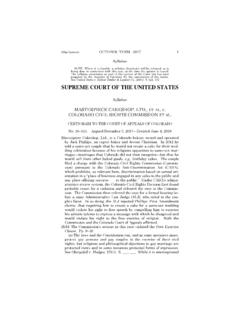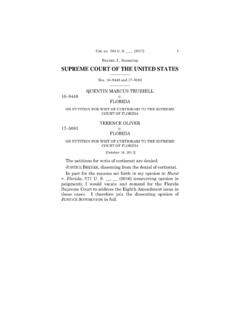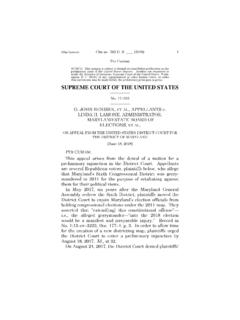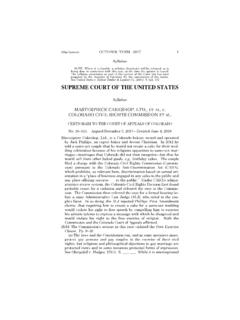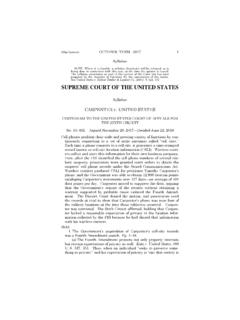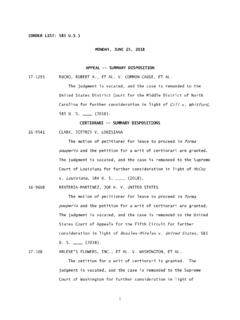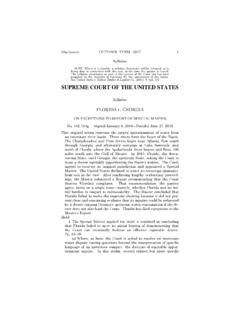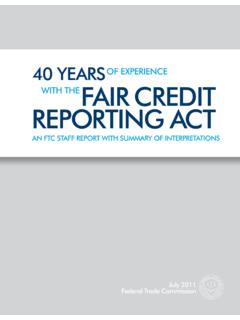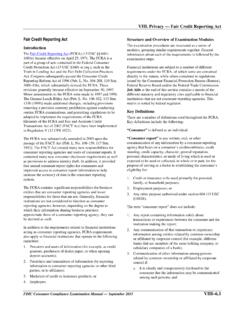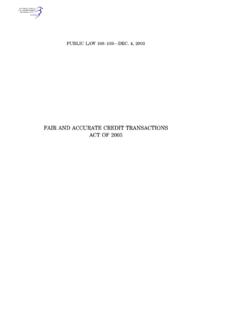Transcription of SUPREME COURT OF THE UNITED STATES
1 1 (Slip Opinion) OCTOBER TERM, 2020 Syllabus NOTE: Where it is feasible, a syllabus (headnote) will be released, as is being done in connection with this case, at the time the opinion is issued. The syllabus constitutes no part of the opinion of the COURT but has been prepared by the Reporter of Decisions for the convenience of the reader. See UNITED STATES v. Detroit Timber & Lumber Co., 200 U. S. 321, 337. SUPREME COURT OF THE UNITED STATES Syllabus TRANSUNION LLC v. RAMIREZ CERTIORARI TO THE UNITED STATES COURT OF APPEALS FOR THE NINTH CIRCUIT No. 20 297. Argued March 30, 2021 Decided June 25, 2021 The fair credit reporting Act regulates the consumer reporting agencies that compile and disseminate personal information about consumers.
2 15 U. S. C. 1681 et seq. The Act also creates a cause of action for con-sumers to sue and recover damages for certain violations. 1681n(a). TransUnion is a credit reporting agency that compiles personal and financial information about individual consumers to create consumer reports and then sells those reports for use by entities that requestinformation about the creditworthiness of individual consumers. Be-ginning in 2002, TransUnion introduced an add-on product called OFAC Name Screen Alert. When a business opted into the Name Screen service, TransUnion would conduct its ordinary credit check of the consumer, and it would also use third-party software to compare the consumer s name against a list maintained by the U.
3 S. Treasury Department s Office of Foreign Assets Control (OFAC) of terrorists, drug traffickers, and other serious criminals. If the consumer s first and last name matched the first and last name of an individual on OFAC s list, then TransUnion would place an alert on the credit reportindicating that the consumer s name was a potential match to a name on the OFAC list. At that time, TransUnion did not compare any dataother than first and last names. A class of 8,185 individuals with OFAC alerts in their credit files sued TransUnion under the fair credit reporting Act for failing to usereasonable procedures to ensure the accuracy of their credit files. The plaintiffs also complained about formatting defects in certain mailingssent to them by TransUnion.
4 The parties stipulated prior to trial that only 1,853 class members (including the named plaintiff SergioRamirez) had their misleading credit reports containing OFAC alerts provided to third parties during the 7-month period specified in the 2 TRANSUNION LLC v. RAMIREZ Syllabus class definition. The internal credit files of the other 6,332 class mem-bers were not provided to third parties during the relevant time period. The District COURT ruled that all class members had Article III stand-ing on each of the three statutory claims. The jury returned a verdict for the plaintiffs and awarded each class member statutory damages and punitive damages.
5 A divided panel of the Ninth Circuit affirmed in relevant part. Held: Only plaintiffs concretely harmed by a defendant s statutory viola-tion have Article III standing to seek damages against that private de-fendant in federal COURT . Pp. 6 27.(a) Article III confines the federal judicial power to the resolution of Cases and Controversies in which a plaintiff has a personal stake. Raines v. Byrd, 521 U. S. 811, 819 820. To have Article III standing to sue in federal COURT , a plaintiff must show, among other things, that the plaintiff suffered concrete injury in fact. Lujan v. Defenders of Wildlife, 504 U. S. 555, 560 561. Central to assessing concreteness iswhether the asserted harm has a close relationship to a harm tradi-tionally recognized as providing a basis for a lawsuit in American courts.
6 Spokeo, Inc. v. Robins, 578 U. S. 330, 340. That inquiry asks whether plaintiffs have identified a close historical or common-law an-alogue for their asserted injury. Physical or monetary harms readilyqualify as concrete injuries under Article III, and various intangibleharms like reputational harms can also be concrete. Ibid. Article III standing requires a concrete injury even in the context of a statutory violation. Ibid. The COURT has rejected the proposition that a plaintiff automatically satisfies the injury-in-fact requirement whenever a statute grants a person a statutory right and purports to authorize that person to sue to vindicate that right. Id., at 341. An injury in law is not an injury in fact. Pp. 6 14.(b) The COURT applies the fundamental standing requirement of con-crete harm to this case.
7 Pp. 15 27.(1) In their reasonable-procedures claim, all 8,185 class membersmaintain that TransUnion did not do enough to ensure that mislead-ing OFAC alerts labeling them as potential terrorists were not in-cluded in their credit files. See 1681e(b). TransUnion provided third parties with credit reports containing OFAC alerts for 1,853 class members (including the named plaintiff Ramirez). Those 1,853 class members therefore suffered a harm with a close relationship to theharm associated with the tort of defamation. Spokeo, 578 U. S., at 341. Under longstanding American law, a person is injured when a defam-atory statement that would subject him to hatred, contempt, or ridi-cule is published to a third party. Milkovich v. Lorain Journal Co.
8 , 497 U. S. 1, 13. The COURT has no trouble concluding that the 1,853class members suffered a concrete harm that qualifies as an injury in 3 Cite as: 594 U. S. ____ (2021) Syllabus fact. The credit files of the remaining 6,332 class members also contained misleading OFAC alerts, but the parties stipulated that TransUnion did not provide those plaintiffs credit information to any potentialcreditors during the designated class period. The mere existence of inaccurate information, absent dissemination, traditionally has not provided the basis for a lawsuit in American courts. The plaintiffs can-not demonstrate that the misleading information in the internal creditfiles itself constitutes a concrete harm.
9 The plaintiffs advance a separate argument based on their exposureto the risk that the misleading information would be disseminated in the future to third parties. The COURT has recognized that material risk of future harm can satisfy the concrete-harm requirement in the context of a claim for injunctive relief to prevent the harm from occur-ring, at least so long as the risk of harm is sufficiently imminent and substantial. See Spokeo, 578 U. S., at 341 342 (citing Clapper v. Am-nesty Int l USA, 568 U. S. 398). But TransUnion advances a persua-sive argument that the mere risk of future harm, without more, cannotqualify as a concrete harm in a suit for damages. The 6,332 plaintiffsdid not demonstrate that the risk of future harm materialized.
10 Nor did those plaintiffs present evidence that the class members were in-dependently harmed by their exposure to the risk itself. The risk of future harm cannot supply the basis for their standing. Pp. 16 24. (2) In two other claims, all 8,185 class members complained aboutformatting defects in certain mailings sent to them by TransUnion. But the plaintiffs have not demonstrated that the format of TransUn-ion s mailings caused them a harm with a close relationship to a harm traditionally recognized as providing a basis for a lawsuit in American courts. See Spokeo, 578 U. S., at 341. The plaintiffs argue that TransUnion s formatting violations createda risk of future harm, because consumers who received the information in the dual-mailing format were at risk of not learning about the OFAC alert in their credit files and thus not asking for corrections.
